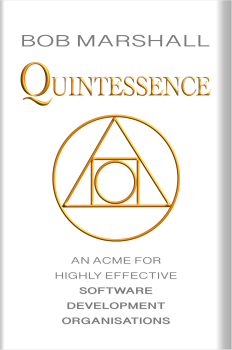Interactive Book: Quintessence – Chapter 20, Coevolution
Sidecar for Chapter 20 of “Quintessence” (Coevolution)
Selected ChatGPT Prompts
Coevolution refers to the process of changing collective assumptions and beliefs in step with organisational change. In the context of this chapter, coevolution involves simultaneously updating an organisation’s mindset, rules, policies, and procedures to ensure that they align with innovations and enable organisations to fully benefit from them. The following prompts are designed to help you explore various aspects of coevolution and adapt them to your needs. Use these prompts as a starting point for your research or discussions on this topic.
- [Purpose] Understand the basic concept of coevolution in organisations.
[Prompt] What is coevolution in the context of organisational change, and why is it important? - [Purpose] Learn how old rules can block the benefits of innovation.
[Prompt] Explain the relationship between old rules and the limitations they impose on an organisation’s ability to benefit from innovation. - [Purpose] Explore the role of rules and policies in organisational coevolution.
[Prompt] How do rules, policies, and procedures affect the process of coevolution in an organisation? - [Purpose] Analyse the need for simultaneous change in collective mindset and organisational practices.
[Prompt] Why is it important for an organisation to change its collective mindset and practices simultaneously during coevolution? - [Purpose] Examine the role of innovation in organisational coevolution
[Prompt] How does innovation contribute to the process of coevolution, and what are the potential benefits of successful coevolution? - [Purpose] Investigate the barriers to coevolution in organisations.
[Prompt] What are the common obstacles faced by organisations in achieving successful coevolution, and how can they be overcome? - [Purpose] Discuss the importance of adaptability in coevolution.
[Prompt] Why is adaptability crucial for organisations undergoing coevolution, and what strategies can help promote adaptability? - [Purpose] Explore the concept of quintessential organisations.
[Prompt] Define a quintessential organisation and explain how it remains constantly alert to the need for coevolution. - [Purpose] Delve into real-world examples of coevolution in organisations.
[Prompt] Provide examples of organisations that have successfully implemented coevolution, and discuss the key factors that contributed to their success. - [Purpose] Investigate the role of leadership in organisational coevolution.
[Prompt] What role does leadership play in promoting and managing coevolution within an organisation?
These prompts are designed to help readers explore various aspects of coevolution using ChatGPT-4. They can be used as-is or customised to fit specific needs or areas of interest. By engaging with these prompts, users can gain a deeper understanding of coevolution and its significance in organisations.
Suggested Learning Path on the Topic of “Coevolution”
- Understanding Coevolution.
[Prompt] Define coevolution in the context of organisational change and explain its importance for enabling the benefits of innovation.
[Exercise] Reflect on a recent change or innovation within your organisation and evaluate whether coevolution occurred, or if old rules and procedures hindered the change’s potential benefits. - Identifying Old Rules and Limitations.
[Prompt] Describe the relationship between old rules in an organisation and the limitations they impose on benefiting from innovation.
[Exercise] List three old rules or procedures within your organisation that might be impeding progress or the adoption of new innovations, and consider how they can be updated or eliminated. - Embracing Adaptability.
[Prompt] Explain the significance of adaptability in organisational coevolution and the strategies that can help promote it.
[Exercise] Assess your organisation’s adaptability by identifying areas where it has been successful in adapting to change and areas where it has struggled. Develop recommendations to enhance adaptability in areas of struggle. - The Role of Leadership in Coevolution.
[Prompt] Discuss the role of leadership in promoting and managing coevolution within an organisation.
[Exercise] Analyse the leadership style in your organisation and identify strengths and weaknesses in terms of fostering coevolution. Create an action plan to address the weaknesses. - Creating a Quintessential Organisation.
[Prompt] Define a quintessential organisation and explain how it remains constantly alert to the need for coevolution.
[Exercise] Assess your organisation’s current approach to coevolution and compare it to the concept of a quintessential organisation. Identify three areas for improvement and propose strategies to address them.
This learning path offers a structured approach to exploring the topic of Coevolution in the context of quintessential organisations.
Some Alternative Learning Paths
There are several other learning paths that might be useful in the context of Coevolution. Here are five suggestions:
- Understanding Organisational Change Management: This learning path focuses on the principles and strategies of managing change within an organisation, including identifying the need for change, communication, and stakeholder engagement.
- Fostering a Culture of Innovation: This learning path would help learners understand the components of a culture that supports innovation and how to nurture and maintain such a culture within an organisation.
- Developing Effective Organisational Communication: In this learning path, learners explore various aspects of communication within an organisation, including channels, strategies, and techniques for improving communication during coevolution and other change processes.
- Implementing Agile Practices in Organisations: This learning path covers the principles of agile methodologies, which promote adaptability and responsiveness to change. It would provide learners with an understanding of how to apply agile practices to support coevolution within their organisation.
- Evaluating and Updating Policies and Procedures: This learning path would focus on the process of reviewing, updating, and implementing new policies and procedures that support coevolution, ensuring that an organisation’s rules and guidelines align with its evolving mindset and objectives.
These learning paths can serve as a starting point for further exploration of the topic of coevolution in the context of quintessential organisations or any organisation in general. Ask ChatGPT to elaborate on one or more of these paths, or suggest others.

